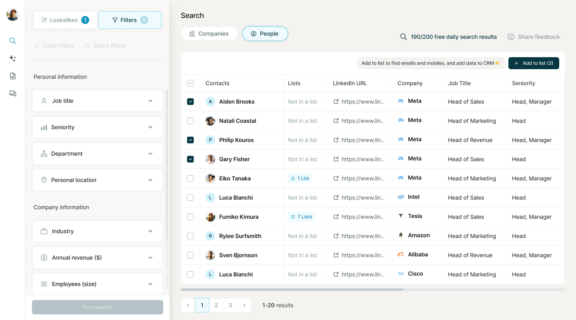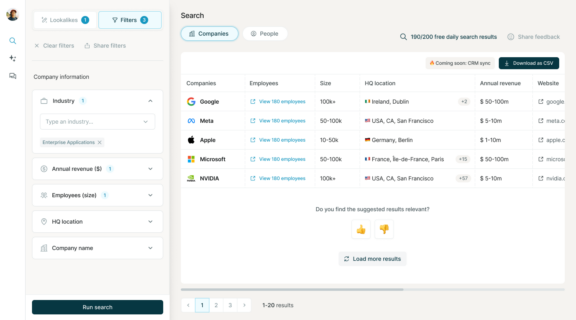Your Step-by-Step Guide to Building an ABM List

You know when something is just right?
The amount of milk in your cup of tea. How warm the weather is outside. The size of your bowl of porridge (if you’re Goldilocks, that is).
It’s a good feeling, isn’t it? Well, the same thing happens when you nail your ABM list. Outreach feels pretty effortless, your audience is engaged, businesses move through the buying cycle efficiently…in other words, life’s pretty sweet.
Unfortunately, the opposite can happen too. Employing an ABM strategy means treating high-value accounts like markets in order to create a pitch-perfect, ultra-personalized customer experience. Get it wrong and your personalization will miss the mark. You’ll struggle to connect with buyers – and ultimately, to make sales.
A lot of your ABM strategy’s success or failure hinges on how effective your list is. If it’s brimming with ICP-alikes and each business has high growth potential, you’re on the money. To nail your list from the get-go, you’ll need to understand what businesses you want on it, actually find them, make sure you have all the data you need and constantly keep things up to date.
If this sounds like a tall order – you’re right. It is, but that doesn’t mean you have to panic. This blog post has everything you need:
- Identifying Key Accounts
- Mapping Decision-Makers and Influencers
- Enriching Your ABM List with Data
- Using Technology to Support List Building
Ready to go? Us too – let’s get started.
Understanding Your Ideal Customer Profile (ICP)
Simply put, an Ideal Customer Profile (ICP) is a detailed description of your business’s perfect match. On their side, they’ll benefit from your product and see a need for it. On your side, they’re easy to sell to and retain, and they’re able to spend on the size of deal your business needs to grow.
Having an ICP is crucial for ABM list creation. Why? Well, create an ABM list without one and you’ll likely end up targeting a pretty random selection of businesses. Some might not have the pains your product solves, some might not have the budget, some might not believe in what you do…none of these sound very easy to connect with, let alone close a deal with, right? Right.
Fail to do the groundwork and build an ICP, and you’re going to end up wasting a lot of time, and a lot of money. Not good for your business’s bottom line, or for you.
Now you’re all on board – here’s how to actually do it.
Research and Data Gathering
The best place to start is with businesses you’ve already sold to. Which are your best customers? Which have made significant contributions to your business growth?
You can find this information in your CRM – and make sure to ask your sales teams too. Once you’ve run through your current customer list, you should start to have an idea of common traits of high-value accounts.
We’d recommend bringing firmographics such as industry, company size and revenue into the mix too. Revenue in particular is a good indicator of whether a business has the cash to spend on the size of deal you need, while industry and company size give you an idea about how to connect with the business and what the buying cycle might look like.
Technographics (what technology they use) is another factor to consider. You might find that your ideal customers have a very similar tech stack – or perhaps your product needs a specific type of infrastructure in place to work.
KPIs to consider: metrics like deal size, sales cycle length, and customer lifetime value are all indicators of the type of customer you want to attract.
If you need help identifying people who match your ICP, you can now use Surfe to find key decision makers, prospects, or companies similar to those you have already closed deals with.

Identifying Key Accounts
Ok, so now you know what an ideal business for your ABM outreach list looks like – but how on earth do you find them?
Prioritizing High-Value Targets
Start by thinking about your targets in terms of value. A high-value target is a company that aligns with your ICP and has high growth potential. You’ll want to select these using market intelligence tools, and then figure out how to prioritize them. Without further ado:
Step 1: Utilize Market Intelligence Tools
There are plenty of tools out there to help you find these high-value targets, by showing you a business’s company size, growth and potential.
LinkedIn Sales Navigator is a good one here, as you can apply filters to a list until you’re looking at a very specific set of businesses. For example, you can use filters like, for example, industry and location to find your ICP before narrowing the list down even further to focus on employee headcount and revenue. LinkedIn Sales Navigator also has a ‘Company Summary’ feature which lets you see key information like this at a glance.
If you’ll forgive us for tooting our own horn for a minute, we think Surfe will do a fantastic job too. You can apply powerful filters to Surfe’s database to find the right businesses, and also use a feature called ‘Company Lookalikes’ that will find businesses similar to those already on your list.
Step 2: Segmenting Your Target Accounts
So, you’ve got a list of target accounts – now you want to prioritize them.
Let’s take an example. Say you’re working for a business that wants as big a business as possible on its books. Your first tier of the most strategic accounts would be made up of enterprise clients, your second tier would have upper mid-sized companies, and so on and so forth.

Mapping Decision-Makers and Influencers
Building an ABM list doesn’t just end with finding companies (sorry if you thought that was it). Most B2B purchases involve multiple stakeholders and it’s important to have a deep understanding of every stakeholder involved in the deal.
Generally speaking, this group of stakeholders is known as a buying committee. These might be formally assembled – or they might be an informal group of people you’ve identified as having a say in the deal.
If you put your efforts into the wrong person, or you neglect to sell to the entire buying committee, you’re wasting time and effort and risk the deal being delayed, blocked, or – eeek – not going ahead at all.
We’re pretty sure you don’t want that to be happening – so let’s find out how you’re going to prevent it.
Research Decision-Makers
The most important person on the buying committee, decision-makers have the power to make your deal go ahead – or stop it in its tracks. Each B2B deal has, on average, 7 decision-makers. They might include C-Level Executives, Heads of Department or Influencers (no, not the type you find on Instagram – we mean people that exert some sort of influence on the decision).
LinkedIn Sales Navigator has a feature called Relationship Mapping to spec out these relationships – and you can use LinkedIn and Surfe to build detailed profiles of each person.
Building Relationships with Multiple Stakeholders
Once you’ve identified these stakeholders, it’s time to build relationships with each and every one.
This is going to vary depending on where you are in the sales cycle. In the beginning, it might mean connecting with everyone on LinkedIn so they know who you are, and get a sense of what you’re about from your content. Later down the line, it might be sharing sales enablement materials that specifically speak to the pain points of someone on the buying committee. The point is to focus on creating a personalized experience for each and every stakeholder. Easy!
Enriching Your ABM List with Data
Now you’ve got a nice, rich ABM list full of businesses you want to sell to – and the people within them. But does your list have everything you need to carry the deal through to a close?
The Importance of Data Enrichment
It’s super important to have data that’s accurate and up-to-date. Say you don’t have an email address for someone on the buying committee, to use a simple example. You feel they’re a bit unsure when you meet them during your demo call but need to ask your champion to share their details before you can put their mind at rest. They take a few days to get back – and in the meantime, their doubts are growing and growing. See what we mean?
Data Enrichment Strategies
You can use third-party data sources and research to fill the gaps in your ABM list:
Contact data: sorry, us again! Surfe will enrich an entire ABM contact list with email addresses and phone numbers in just one click – and thanks to its waterfall enrichment technology, they’ll be accurate too.
Firmographic and technographic data: sources like LinkedIn and industry publications are helpful here – and pay attention to what your ICP tells you as well.
We’d also recommend keeping track of account activities like mergers or product launches – these could very easily impact your strategy. Again LinkedIn and industry publications will be helpful here.
KPIs to Track: to make sure you’re on the right course, we’d recommend keeping an eye on the number of decision-makers identified per account, engagement metrics like open rates or responses and conversion rates from enriched leads.
Using Technology to Support List Building
As you’ve probably already gathered, building these lists is a pretty chunky task – and that’s before you even start the delicate process of actually selling to them.
Fortunately, there are plenty of tools and technologies to help you. Marketing automation tools and CRMs can really help speed up the process – at the very least, these should integrate with each other. More likely, if you have a decent CRM there’s a chance it’ll come with its own automation features that’ll make list building a breeze.
Segmenting and Personalizing at Scale
These technologies also help you segment your lists, and then personalize messaging for each segment. Pretty clever!
Let’s say you’ve got a list of people working at a business of a certain size – but the people themselves might have different roles, and therefore different pain points. A good automation tool could segment this list by role, and then outreach with messaging focussed around each role’s different pain points.
This is really, really helpful when you’re working at scale – as it enables you to keep on top of your list without losing the personal touch that’s so important to an ABM strategy.
Collaborating with Sales for List Optimization
Ok, we know Account-Based Marketing’s name refers to the Marketing team – but that doesn’t mean it’s a Marketing-only job. Far from it.
Sales and Marketing Alignment
It’s really important to work with the Sales team during the list-building process – in fact, it’s going to make your life far, far easier. The Sales team can make sure marketing is targeting accounts that they can actually close and will be able to provide vital insights from later on in the cycle to inform the list.
You should make sure to set up regular feedback loops – whether this takes place over Slack, in a meeting, or somewhere else – to keep the lists in top shape. Sales should regularly be providing feedback on the quality of the ABM list and what the real-world engagement looks like.
Refining and Maintaining the List
You should be constantly refining and maintaining your ABM list to make sure it remains relevant.
As well as the aforementioned feedback from the sales team, you’ll want to remove companies that no longer fit the ICP or have shown no engagement over time. Doing so means that your time won’t be wasted crafting perfect messages for accounts that won’t close – leaving you more time to focus on the right people instead.
KPIs to Track: engagement metrics, pipeline velocity and close rates will all help you get an idea of the health and quality of your list.
Let’s Wrap It Up!
Someone call Goldilocks – you now know how to get things just right, every time! Take a methodical approach to building your ABM list by understanding what businesses you want, finding them and the stakeholders who work for them, making sure you have the data you need and constantly keeping things up to date, and you’re onto a winner. Now, time to get onto the actual selling. Good luck!

Ready to start getting your ABM lists right?
We know the answer already – and that’s where Surfe comes in. Try it today (it’s free!) and you’ll be building ABM lists at the speed of light.


